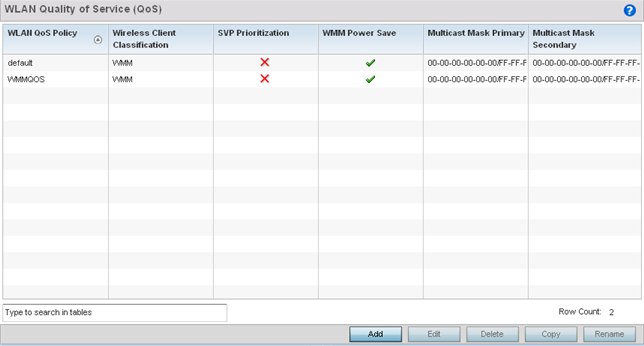QoS (Quality of service) provides a data traffic prioritization scheme. QoS reduces congestion from excessive traffic. If there is enough bandwidth for all users and applications (unlikely because excessive bandwidth comes at a very high cost), then applying QoS has very little value. QoS provides policy enforcement for mission-critical applications and/or users that have critical bandwidth requirements when bandwidth is shared by different users and applications.
QoS helps ensure each WLAN receives a fair share of the overall bandwidth, either equally or as per the proportion configured. Packets directed towards clients are classified into categories, for example Video, Voice, and Data. Packets within each category are processed based on the weights defined for each WLAN.
The Quality of Service screen displays a list of QoS policies available to WLANs. If none of the exiting QoS policies supports an ideal QoS configuration for the intended data traffic of this WLAN, click Add to create new policy. Select the radio button of an existing WLAN and click OK to map the QoS policy to the WLAN displayed in the banner of the screen.
Use the WLAN Quality of Service (QoS) Policy screen to add a new QoS policy or edit the attributes of an existing policy. Each access point model supports up to 32 WLAN QoS policies.

Note
WLAN QoS configurations differ significantly from QoS policies configured for radios. WLAN QoS configurations are designed to support the data requirements of wireless clients, including the data types they support and their network permissions. Radio QoS policies are specific to the transmit and receive characteristics of the connected radios themselves, independent from the wireless clients the access point radios supported.
| WLAN QoS Policy | The name assigned to this WLAN QoS policy. The assigned policy name cannot be modified. |
| Wireless Client Classification | Each policy's Wireless Client
Classification as defined for this WLAN's intended traffic. The
Classification Categories are the different WLAN-WMM options available
to a radio. Classification types include:
|
| SVP Prioritization | A green check mark defines the policy as having SVP (Spectralink Voice Prioritization) enabled to allow the wireless controller to identify and prioritize traffic from Spectralink/Polycomm phones using the SVP protocol. Phones using regular WMM and SIP are not impacted by SVP prioritization. A red "X" defines the QoS policy as not supporting SVP prioritization. |
| WMM Power Save | Enables support for the WMM based power-save mechanism, also known as U-APSD (Unscheduled Automatic Power Save Delivery). This is primarily used by voice devices that are WMM capable. The default setting is enabled. |
| Multicast Mask Primary | The primary multicast mask defined for each listed QoS policy. Normally all multicast and broadcast packets are buffered until the periodic DTIM interval (indicated in the 802.11 beacon frame), when clients in power save mode wake to check for frames. However, for certain applications and traffic types, the administrator may want the frames transmitted immediately, without waiting for the DTIM interval. By configuring a primary and secondary multicast mask, an administrator can indicate which frames are transmitted immediately. Setting masks is optional and only needed if there are traffic types requiring special handling. |
| Multicast Mask Secondary | The secondary multicast mask defined for each listed QoS policy. |
A WLAN Quality of Service (QoS) policy screen displays for the new or selected WLAN. The screen displays the WMM tab by default, but additional tabs also display for WLAN and wireless client rate limit configurations. For more information, refer to the following: